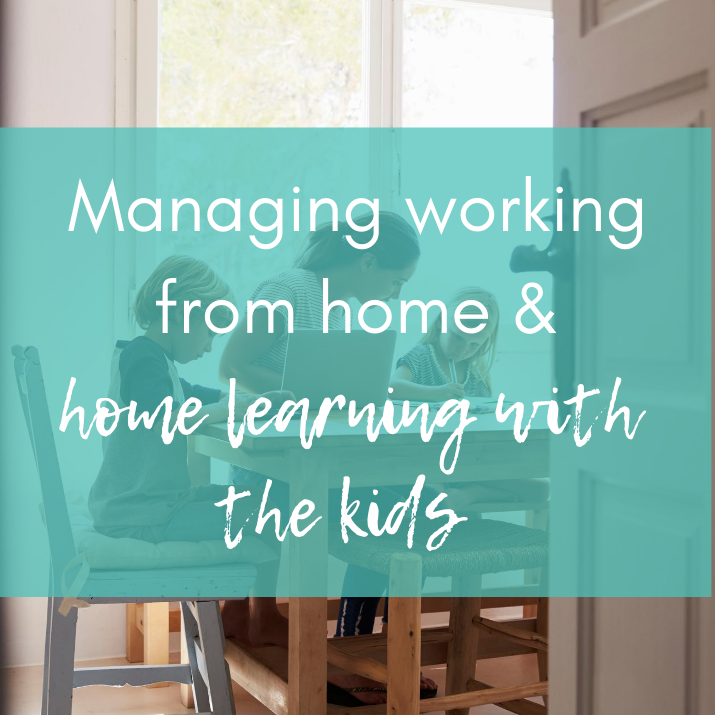
This post is part of a series that I am writing in response to reader requests on what topics will help them through this stage of the COVID-19 pandemic. You can find other posts in the series here.
I have been working at home for 12 years and in that time I have combined working at home for a variety of hours and under a variety of conditions – with a newborn, multiple little ones home full time, only one child at home, then all kids at school, then uni kids at home. Each stage has had its challenges for working productively from home, but nothing quite like the challenges the COVID-19 pandemic has provided.
I can only imagine if your first experience of working from home is the current situation where you also have kids at home full time with you and you have to oversee home learning, you are most likely finding it super hard. I know from talking with many mums and receiving emails from readers many are finding it tough. When I asked for topics recently, this was a selection of responses I received around work/home life:
- How to get a work routine happening.
- Ideas for work motivation and effective planning.
- Work bleeds into home life, home life bleeds into work – not sure how to prevent this when we don’t leave the house!
When we were in the first wave of stay at home restrictions, I wrote these posts on the topic of working from home:
- Home learning and working from home – readers share a snapshot of their lives – this post shared examples from readers from South Africa, New Zealand and Australia
- Tips for working from home with the kids at home
- Using planning to help keep family harmony as you stay at home for COVID-19
But for those of us who are still doing the work from home and home learning gig, the general feeling I get (and feel myself!) is it definitely is starting to feel harder and trickier to manage. So while the above posts do have great tips and if you haven’t read them yet, I highly recommend you do, but I feel that this phase of the work from home and home learning requires different strategies and a different mindset. Here are some steps you can take to help you manage working from home and home learning:
1. Setting realistic expectations for yourself
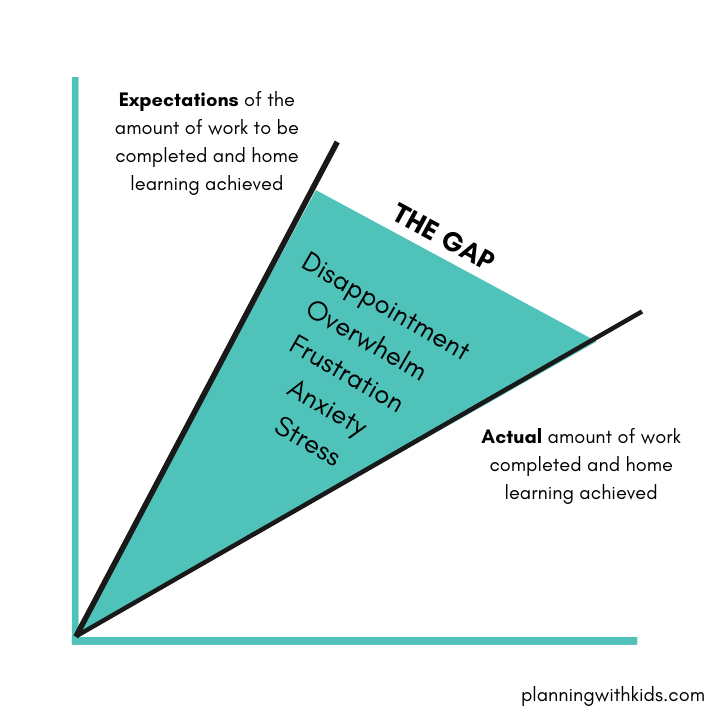
A good deal of pain and suffering in any situation comes from the gap between expectations vs reality. Realistic expectations are always important, but now they are critical. They are critical to our happiness and our happiness or lack thereof flows onto the family, so our expectations can impact the overall happiness of the whole family.
If we have unrealistic expectations about the work we can achieve and how much home learning we can do with the kids when reality hits us and we get much less done, this gap can leave us feeling any or all of the following emotions:
- disappointment
- overwhelm
- frustration
- anxiety
- stress
As the primary carer for the bulk of the school week, I have accepted that I am not going to get as much work completed as I would when the kids are at school during the weekdays. This means I will catch up on work in the evenings, early mornings, and on weekends.
I used to have strict boundaries about when I would work and previously evenings and weekends have been out of bounds. This is not a realistic boundary for me at this time and I have accepted I will be working at these times. Changing my expectations helped considerably reduce my feelings of frustration and disappointment that I was spending my usual “time off” working. I am working a similar number of hours a week just across different times.
Not everyone will have as much flexibility with their work as I do, as you may have more scheduled Zoom meetings for example or deadlines to meet by COB. But when you acknowledge that you cannot keep the same work pattern as you would at your office and look for ways to adapt and change across an entire seven day period, you will find there is some flexibility in your day. Changing your expectations is a key part of this process. You may need to work with your employer on this one too and I cover that in step 2.
I have heard from many parents working at home, that they have adjusted their expectations significantly with the second round of home learning. Yes, they are still encouraging their kids to do their work and supporting them where they can, but they are being realistic about what can be achieved across the day without tears (by parents or children). Many have told me that they are sticking with the foundational work – the English and Maths, etc and if they need to let go of the complicated art project then they will.
2. Setting realistic expectations with your boss

For those who don’t work for themselves and have an external boss to report to, having a discussion with your boss about what are realistic expectations for you at the moment can help alleviate stress and avoid misalignment about availability. The receptiveness of your employer may differ but it is definitely worth having a discussion to see how you can tailor your workdays to combine home learning and working from home. Here are some temporary setups some mums I know have been able to arrange with their employers:
- taking one annual leave day a week so they have less hours to work for this second wave of home learning
- working a split shift – being online for a number of hours during the core business day and then doing a second shift once the kids are in bed
- working one day on the weekend so the partner can look after the kids and having a day off during the week
3. Setting realistic expectations with your partner
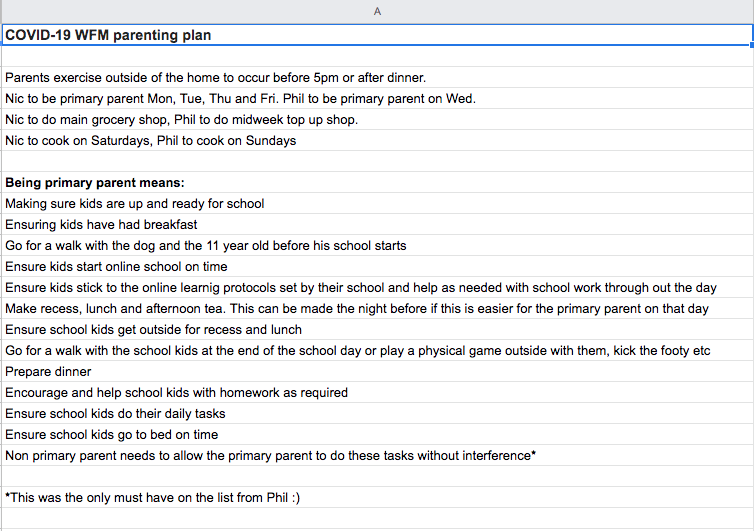
I realise that not everyone lives in a two adult home, so this strategy won’t be suitable to everyone. To all those solo parents out there, you are doing an amazing job! I very much need and appreciate the break I get from being the primary parent in our house from time to time, being able to tag another parent in when needed or simply have support from my partner.
In the last lockdown, my husband and I had a major breakthrough in how we were managing the working from home and home learning with the kids. As I work part-time, I had been what we refer to as the “primary parent” on the weekdays during the COVID-19 restrictions. This meant that my husband was able to be off in his home office (aka the card table set up in our bedroom) and work uninterrupted.
This system worked in the short term, but the amount of work I was able to complete was reduced significantly by this. We then worked together to create a COVID-19 WFM parenting plan. It documented who did what on which days and allocated one day a week to my husband where he was the primary parent and needed to oversee the home learning and other home duties for the day. On that one day, I create more output than I do for the rest of the days combined!
The key is to work together to put in place a known schedule of who is doing what and when to prevent assumptions and one parent feeling resentful about having to carry the bulk of the load. Of course this may need to change from time to time due to work commitments – this week the primary parent day for my husband is actually Thursday because he had important meeting ons Wednesday that he could not reschedule.
4. Know the kids’ home learning schedule
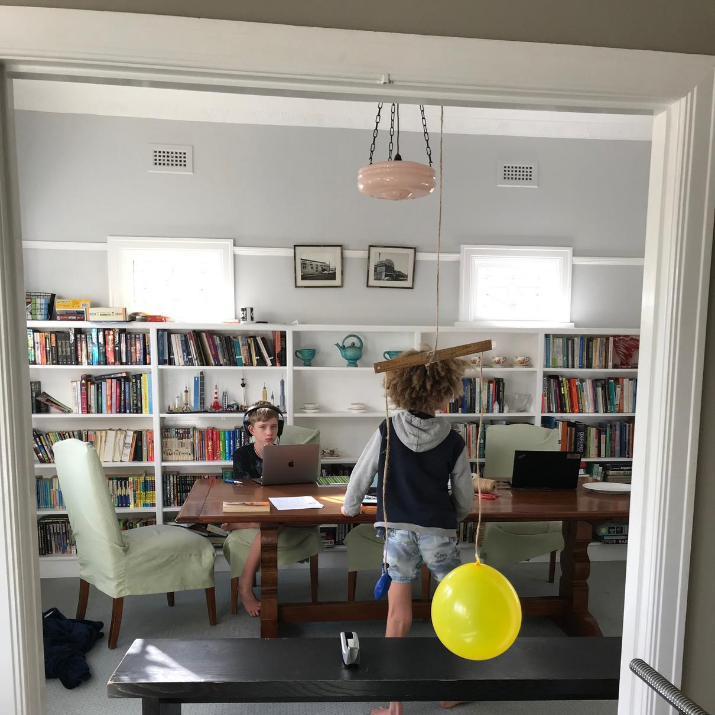
Only one of the kids’ home learning schedule really impacts on my work. Yes the others may have times that they need help with the printer that won’t work or have some other issues I need to assist them with, but on the whole, they are supported all day online by their teachers.
The youngest has only minimal time online each day, so needs more assistance. The work set by the school is quite routine, so I know on Wednesdays he will need assistance with the science experiment for example. Take a look at your kids schedule and see what will be the key times they need you – you probably already know them but it might be with activities like:
- Weekly spelling and times table test
- The weekly art class
- The weekly writing session
Where possible, block out these times in your calendar. But I would have to block out my whole calendar I hear you shout! I know! If you have multiple younger kids then it is super tough because you could literally block out your entire workdays. However as noted at the start, you need to have realistic expectations about what you can achieve and then choose what you think the most important tasks for your child/ren are across the week and block those ones out. You may have a child who is great at maths but needs more help with English, so accepting you cannot do it all, focus on English for that child.
5. Know your deep work tasks

The book Deep Work by Cal Newport is a book I highly recommend to anyone who is a knowledge worker. A knowledge worker is a worker whose main capital is knowledge. It is often said knowledge workers have to think for a living, rather than performing manual or interpersonal tasks.
In the book Newport makes a distinction between “deep work” and “shallow work”.
Deep work is the ability to focus without distraction on a cognitively demanding task. It’s a skill that allows you to quickly master complicated information and produce better results in less time. Deep work will make you better at what you do and provide the sense of true fulfillment that comes from craftsmanship.
Cal Newport
For many of us working from home and managing the home learning of our kids – we are knowledge workers that need to be able to do deep work. The trouble is it is super hard to focus and not be distracted every 15.5 seconds when you have to tend to the needs of the kids!
It is important to understand what your workload is made up of. What are the deep work tasks you need to complete on a regular basis? This might be activities like:
- report writing
- design work
- programming
- assessments
- presentations
It will be these tasks that you need to prioritise when it comes to planning out your week in step 7.
6. Know your shallow work tasks

Shallow work is non-cognitive, logistical or minor duties performed in a state of distraction.
Cal Newport
Regardless of your line of work, we all have shallow tasks that need to be completed. These are the types of activities that you can do with the kids climbing over you, that you can stop and start easily, tasks that don’t require too much cognitive load. These are activities like:
- invoicing
- social media
- timesheets
- running reports
- emails
When it comes to planning out your week in step 7, you allocate these tasks at times when you know you are going to be most interrupted.
7. Conduct a Sunday planning session for your work
Pre-COVID I would create a weekly schedule that allocated my work into blocks across the week. For example the below is a snapshot of what my schedule* looked like last year.
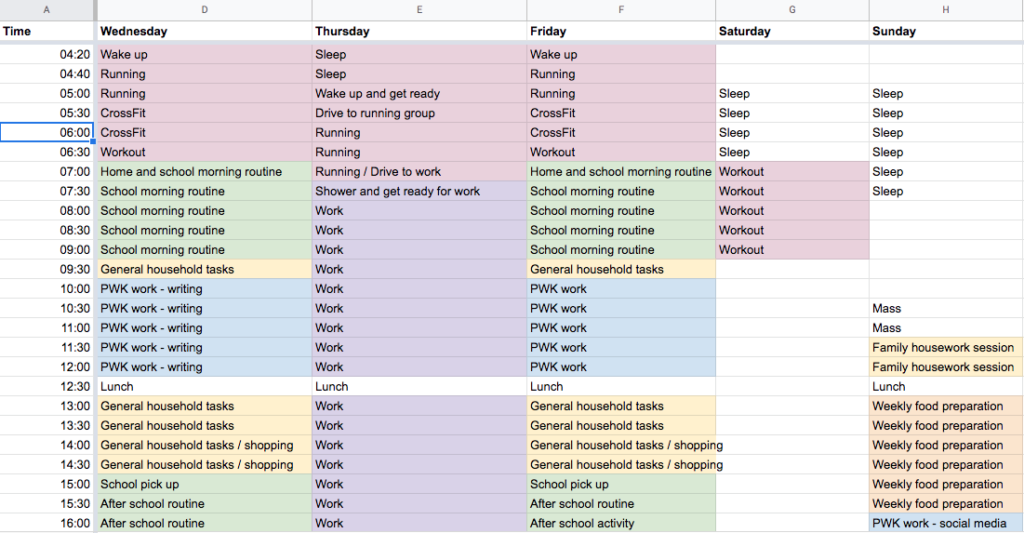
I didn’t revamp my schedule at the start of the year and then COVID-19 hit and I realised that having a schedule like that wasn’t going to work for me at this time.
I am using the same principles behind the weekly schedule planning process, but doing this on a weekly basis on Sundays. I write down all the known tasks I want to complete for the week. Of course, there will always be things that come up, I make sure I leave some space in the week for a few unknowns!
When I write my list down, the first thing I write is my goal for the year and the key project I am working on that is helping me work towards my goal. This simple act of writing down helps bring activities that are most important to my goal top of mind and make their way on their list. Often the urgent activities are the first ones we write on our lists if we aren’t looking at the bigger picture.
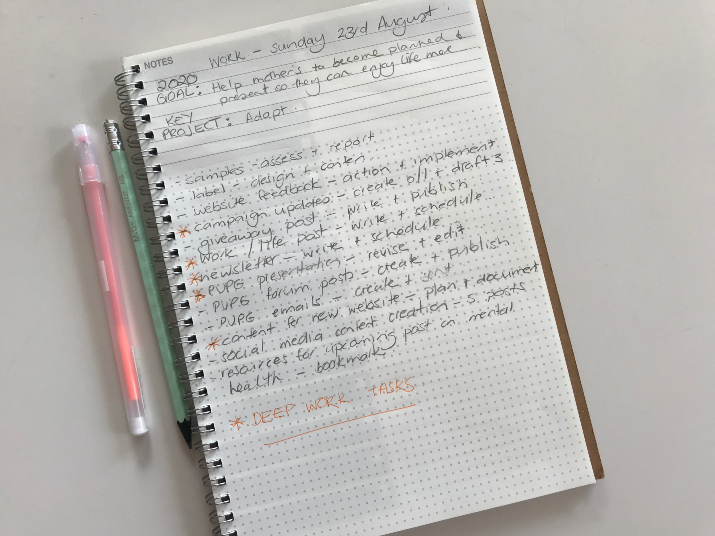
I will then highlight what my deep work tasks are for the week. Taking into account the kids’ schedules (step 4), my husband’s work schedule (step 3) I will make an estimate as to the best times for me to do my deep work and allocate those in my calendar. For example, I will make sure I have a deep work task ready to go as soon as the youngest gets on his Google Meeting for the day.
This may also mean scheduling writing time between 6.00am – 7.00am on a day that I know I will have very little uninterrupted time. I have previously allocated 3 hours blocks of time on Saturdays to allow me to work on tasks that need big blocks of time. It is not ideal, but nothing about these COVID-19 times are ideal!
Choosing to do a deep work task like writing in the middle of the day when I am the primary carer is possible but I have to take note of step 1 and have realistic expectations. I have timed my blog post writing and it takes me generally at least as twice as long to write a post when I have all the kids at home doing online learning, compared to when I am working at home on my own.
I avoid working on any shallow tasks when I have uninterrupted time, preferring to keep them for the key interruption periods of the day. Pre COVID-19 my work day used to end when the kids came home from school. Now I have a break when the kids finish up, get them some afternoon tea and once they have settled into an activity, I will now jump back online and do an hour or so of shallow work to tidy things up for the next day.
8. Plan out the next day at the end of your work day

While I have a plan for how my work week will look, things can and do change. At the end of each day, I will look at my task list for the day, work out what is complete and what I still need to work on. I will write a prioritised list for the next day and allocate deep work tasks to the times with the least interruptions and try all over again to manage the working from home and whole home learning with the kids thing!
How are you managing working from home and home learning?
*If you would like to see my full schedule from last year you can find the Google Sheet here. I was then doing some contract work three days a week outside of the home. The Google Sheet has a template tab, which is a blank version you could use yourself once COVID-19 leaves us or modify it for COVID-19 times.
To be able to edit a copy of this sheet and add your own data, you need to make a copy of the sheet first. To do that you need to:
- Open the spreadsheet
- Click on ‘file’, then ‘make a copy’
- Name the sheet and click on okay
- You will now be able to make whatever changes you like.
You will need a Google account to do this. If you don’t have a Google account already you will need to sign up for one. This doesn’t mean you have to get a Gmail address. Google accounts don’t have to use Gmail addresses. A Google account is simply a unified sign-in system that gives you access to Google products, including Drive, Docs, Sheets, and Slides. You can associate any email address with a Google account. To sign up for a Google Account go here.
